How to sharpen scissors at home (hair, fabric, sewing and manicure)
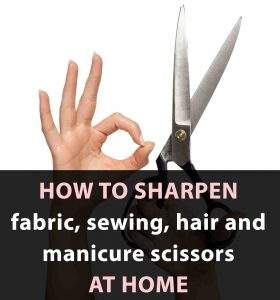 Anyone has few dull scissors. And of course, most of us saw one of the demonstrations how to sharpen scissors at home with sandpaper, aluminum foil or glass jar. The truth is that all these methods are ineffective and may damage your tool. So if you are not in a desperate situation, take sharpening seriously and your results will be much better.
Anyone has few dull scissors. And of course, most of us saw one of the demonstrations how to sharpen scissors at home with sandpaper, aluminum foil or glass jar. The truth is that all these methods are ineffective and may damage your tool. So if you are not in a desperate situation, take sharpening seriously and your results will be much better.
Table of Contents
General principles
Tin foil, glass jar, and sewing pin methods are rather deforming the cutting edge on both sides a bit. It “closes the gap” and make the fit a little tighter between the blades. Therefore the tighter fit actually appears to make your scissors cut cleaner. But to be honest, this is very difficult to say for sure, especially considering that scissors are rarely completely dull in the beginning.
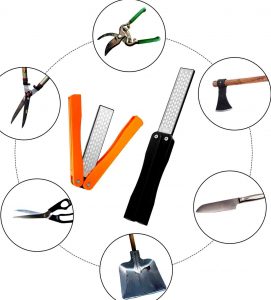
If you do not want to devote some time to manual sharpening, just purchase a special set. Even the the cheapest kit will be more effective than a sewing needle. Some knife sharpeners can be used on scissors, we’ll discuss it below.
The most versatile method is using a stone or file. Just buy a small whetstone or diamond sharpener and slide the blade back and forth over the scissors. If this is not difficult, the blades can be previously separated for convenience.
It is a traditional and perfectly acceptable way to sharpen scissors. But be aware that sharpening the inside grinds of the blades may damage any pair of scissors by helping ensure the cutting edges not meet as the blades are closed. It takes pretty much attention to detail and possibly readjustment of the curvature and pivot of the blades. If you use use a stone, it’s much safer to grind the outside facing bevels.
If you’ve never tried it before, find few pairs of dull cheap scissors, try and see how they stack up.
Sometimes it’s convenient to use the triangle rods and sharpen the blades free-hand. Has worked well for me so far.
How to sharpen fabric scissors
For larger scissors like fabric and sewer you may need power tool, such as Tormek edge sharpener or a belt sander on low speed to get controllable and good results. Any device with angle control helps a lot on when you’re doing expensive shears. Also take into account that many scissors have different angles on each blade. Don’t re-engineer them, just sharpen as it comes.
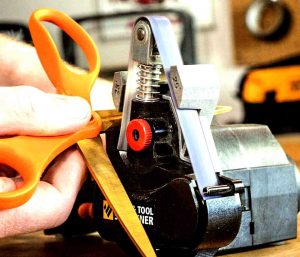
Don’t create too smooth edges, play it safe and sharpen no finer than 220x grit. If the blades are too polished they push the fabric out of the blades rather than grab and cut.
Tighten the screw tight enough to be able to cut the fabric that is expected to be cut. The scissors should be tighter for thicker material and looser for thinner. Carbon bladed shears should be dried off real good and you need to apply oil on each pair. If you forget it, you’ll be making rust very soon.
The absolute best way to deburr a fabric scissors is to run the blades through a wooden block and then crunch the rest off while closing them on a paper towel but not each other. It takes off any burr and performs a test cut at the same time.
If the blades do not close after sharpening, you should remove a little height from the stop to allow the tips to meet.
If you want quick results and don’t need to sharpen your tools every day, just use special sharpeners. In any sewing room there are several types of scissors from Fiskars. And I have used the Fiskars sharpeners on the Fiskars scissors for a long time and they worked nice. All you need is to maintain correct the position of the metal on the edge and don’t grind it down.
How to sharpen kitchen scissors

I sometimes sharpen my own kitchen scissor especially those messed up shears when someone uses them to cut through chicken bones with. I don’t thin out the bevel as this will seriously weaken the edge. Actually, scissors do not generally cuts into the material, but works by shearing. So, you do not need a low bevel angle as you do a knife.
I sharpen various kitchen shears by raising the smallest possible burr on the bevel side and deburring on the back after it. Working this way I never mess with the geometry.
Not all scissors can be taken apart, therefore I grind near the edge of my table so that the second blade points downwards out of the table edge.
Sharpening scissor with sharpeners
Of course, the best way to sharpen any tool is to use the proper machinery to exactly duplicate beveled angle and maintain that angle along the entire cutting surface. Almost any household scissors can be sharpened with table top belt sander. Just grind blades on the belt lightly with the cutting edge facing upwards into the downwards moving belt. Several light passes will be just enough to to create a new cutting surface. You can also buy compact sharpener with 30-70 degree angle guides.
As I already mentioned, I have Fiskars scissor sharpener and use it on all my scissors: spring loaded Fiskars, Mundial metal shears and a small pair of snips. I use the tool to sharpen all of them and it works very well. I open the blades close to the handle and squeeze quite hard, as if cutting through several layers of thick cardboard.
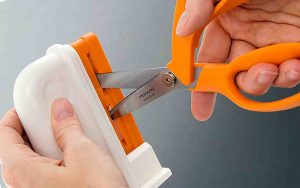
Diamond rods will do great touch-ups on scissors but it usually they are not so good in recreating an edge bevel.
How to sharpen hair scissors at home
When my sister started a beauty school, she started using her scissors. In their intro, the instructor informed students that they will need to send their sheers out to professional sharper and it will cost close to $200.
I consulted about how to sharpen hair scissors at home with an acquaintance who did this work for about five years in salons. And my friend said, that sharpening shears costs about $25 per pair almost everywhere in US and evan super great rep sharpener hardly can get more than $40.
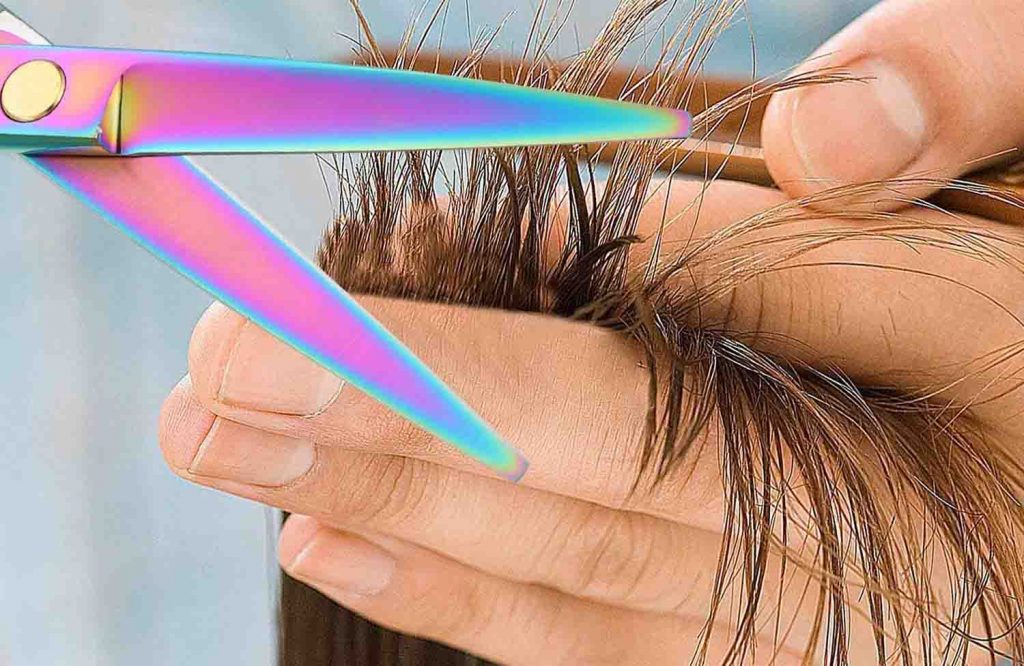
He told me that I’ll ruin the hair scissors with 99% certainty the first time I do it myself. Salon scissors are Japanese convex, barber ones are German style single edge.
Japanese ones have ride lines on the inside and they have to be sharpened properly, the screw usually needs some tweaking, and the angle of the convex face is pretty complex and varies along the length of the blade.
Therefore, for the first time, sharpen hair scissors which can be sacrificed for the sake of experience and (or) there is an opportunity to send them for professional sharpening later. Don’t work with the broad sides, just touch the thin cutting edges, and look really carefully at what you are doing. Study a new sharp scissors, keep it close and constantly look at what you are striving for.
Conclusions
Sharpening scissors is similar to sharpening any other tool. It is a multi step process where each process must be done correctly to perform like new.
This is not rocket science and only requires a little attention and some efforts at first. Plus, you don’t need to invest a lot. A whetstone is sufficient to adjust the cutting edge of your scissors from time to time.
The sharpener makes things easier and if you are not a professional, a $ 10-15 device can solve all your problems.
Handling hair scissors requires a lot of effort and experience, so if it’s not about neat fix of the cutting edge, it’s best to entrust the job to a professional.
Posted on Categories Sharpening